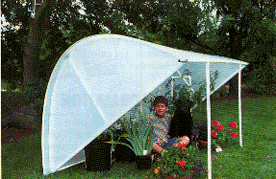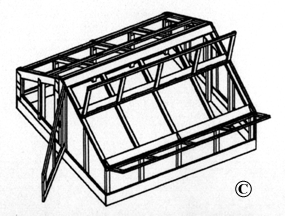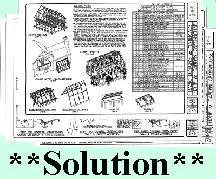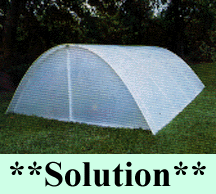|
|
|
COLDFRAMES
A coldframe is a bottomless box with a removable top. It is used to protect small plants from wind and low temperatures. No artificial heat or manure is used inside a true coldframe but many gardeners experiment with a variety of soil conditions. They utilize the sun's heat. The soil inside the box is heated during the day and gives off its heat at night to keep the plants warm. The frame may be banked with straw or strawy manure to insulate it from the outside air and to retain heat.
With a coldframe, you can do many of the same things you do in a greenhouse. You can sow summer flowers and vegetables weeks before outdoor planting. Often, you will gain sufficient time to grow an extra crop. You can start vegetables, annual flowers for fall and winter, and perennials for next year's bloom. Plants are protected from harsh weather and will grow to transplant size quickly. You can root cuttings of deciduous and evergreen shrubs and trees, softwood cuttings of chrysanthemums, geraniums, and fuchsia, and leaf cuttings of rex begonias. African violets and succulent and foliage plants take root faster in a cold-frame, particularly during warmer months. You can also grow your own lettuce, chives, endives, parsley, and green onions right through the winter by converting to a hotbed. Portables can be built in your workshop from surplus materials you may have on hand. Construction can be made from sections of 3 x 4 foot or 3 x 6 foot millwork sash or plastic covered panels. Glass sash is the best type of covering for hotbeds, but is also the most expensive. Other materials, such as plastic coated fabric, or treated muslin provide a satisfactory covering. Most can be converted to hotbeds for use in all seasons by installing electric heat and automatic clock controlled misting or watering.
Hotbed and Propagating Frames
A hotbed is a bed of soil enclosed in a glass or plastic frame. It is heated by manure, electricity, steam, or hot-water pipes. Hotbeds are used for forcing plants or for raising early seedlings. Instead of relying on outside sources of supply for seedlings, you can grow vegetables and flowers best suited to your own garden. Seeds may be started in a heated bed weeks or months before they can be sown out of doors. At the proper time the hotbeds can be converted into a coldframe for hardening. The plants may then be moved to the garden when outdoor conditions are favorable. The hotbed should be located on well drained soil. In some locations a 3-inch layer of gravel under the prepared soil mixture or under flats may be required.
For supplementary heating, electric soil-heating tape or cable with a thermostat to automatically control temperature and make more efficient use of electricity is suggested. Lay the cable on the soil at the bottom of the bed or, if the bed was excavated, lay it on a bed of sand or vermiculite spread on top of the gravel. Cover the cable with about 2 inches of sand. If the seed or cuttings are to be started in a prepared soil bed, rather than in pots or flats, protect the cable by placing hardware cloth or wire screening ( or -inch mesh) about 1 inch above the heating tape or cable to prevent possible damage by cultivating tools. Do not place hotbed cables of any type directly in peat or similar materials. When peat dries out it acts as an insulator and may cause the cable to overheat.
Between 10 and 15 watts of electric heat should be provided for every square foot of growing area in a hotbed. Soil-heating tape or cable is available in several lengths, which give a choice of wattage. (Check with your power supplier or qualified dealer for assistance in selecting and installing heating cable). If the bed is in a sunny, well-sheltered location, and the climate not too severe, 10 watts per square foot should be adequate. Lining the side walls with moisture-proof insulation is desirable. For localities with very cold winters, a higher heat capacity is needed. Fifteen watts per square foot is recommended. The spacing between loops or sections of the cable is important. The formula for this is as follows:
spacing (in inches) = 12 x watts per foot of cable
wattage required per sq ft of bed
The spacing between the outside cable and the wall is half the spacing between cable. Make all connections to the heating cable watertight to exclude moisture. The wiring must conform to the national electrical code and to the requirements of the local power supplier. It should be installed by a representative of the power supplier or by a qualified electrician. Connect a thermostat with an operating range of 30 to 120 degrees F (5 degrees F Differential) in the electric circuit to control the temperature in the bed. Because accurate temperature control is possible with a thermostat, you can grow better plants at lower costs by separating plants requiring different temperatures in different beds. Temperatures from 50 to 79 degrees F are best for hotbeds. On very cold nights cover the beds with mats, burlap, straw, or boards. The thermostat must have sufficient current-carrying capacity to handle the bed or section of bed that it controls.
When the hotbed is used as a propagating frame, cheesecloth can be held in place with stretch cord fastened to eyelet screws on the frame. Mist sprayers can be mounted to removable 2 x 2 board inside the frame and about 1 foot above the cuttings. The location of the sprayers, which keep leaf surfaces moist, depends on the weather. If it is dry and windy, mount the sprayers on the inside. If humid and calm, mount the sprayers on the outside to keep cover moist and cool. Operate the mist sprayer system most of the daylight hours. Keep the frame covered with cheesecloth. If the weather becomes windy and dry before the cuttings have developed roots it is desirable to moisten the cheesecloth several times a day until they do.
***
WEATHERPROOF WIRE
Use weatherproof wire for all outside wiring. Wire size depends upon the distance to be covered and the number of hotbeds to a circuit. Use approved terminal equipment and follow safe wiring practices. All wiring must conform to local wiring codes. Observe these precautions when placing the cable: (1) lay the cable in position carefully to avoid damaging the sheath or conductor. Kinks may damage or break the cable. (2) Do not cross one cable or section of cable over another. (3) Do not shorten the length of a cable. A shortened cable may become too hot and burn out. (4) Do not place the thermostat or bulb directly above a heating cable or allow it to come in contact with a cable.
To Learn More About Planning Your Greenhouse Select Your Area of Interest by 'Clicking' on the Index Text Below.
TYPES OF GREENHOUSES & CONSTRUCTION
GREENHOUSE BASIC DESIGN & LOCATION
GREENHOUSE VENTILATION & COOLING
|
Copyright 2006, All Rights Reserved Including Page and Website "Look & Feel" |

"A Company with Products & Services to Enrich Your World"




